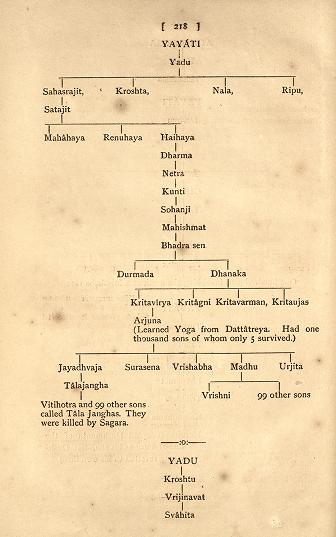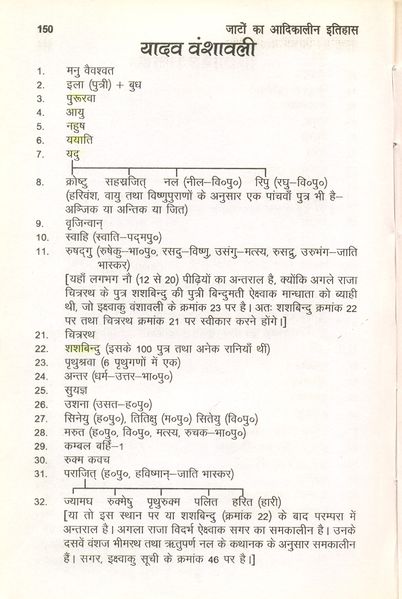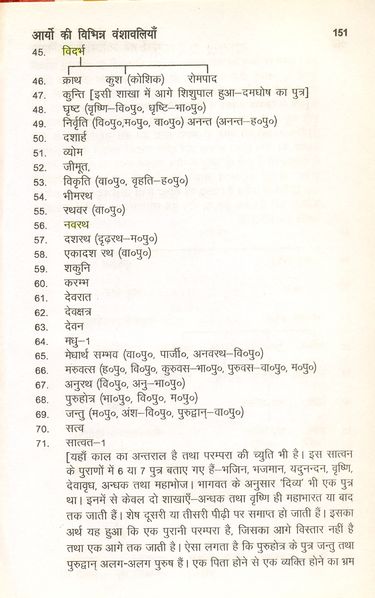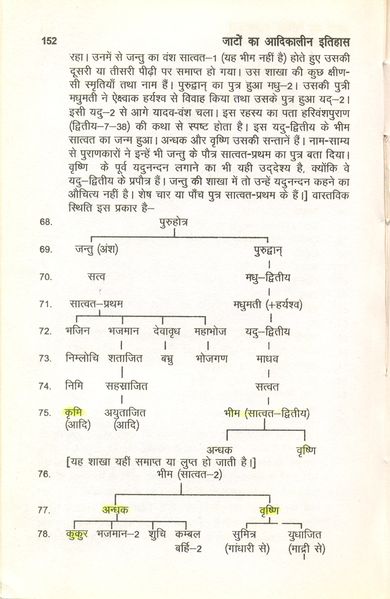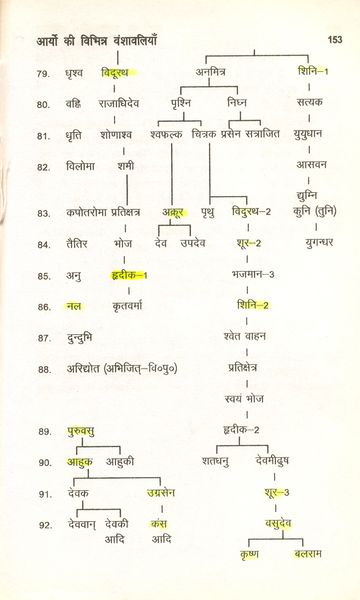
| YADU
Ancestry of Yadu
Ancestry of Yadu
Ancestry of Yadu
Ancestry of Yadu Yadu is the name of one of the five Aryan clans mentioned in the Rig Veda. James Tod places it in the list of Thirty Six Royal Races.
The epic Mahabharata and Puranas refer to Yadu as the eldest son of mythological king Yayati. Yadu was banished from ruling and had become rebel who first started ruling in outskirts of India and then intruded the mainland. The jambudwipa referred in scriptures is believed to be in memory of these islands. The regions where the Yadu clan settled is not certain, but certain scholars suggest that Yadu clan inherited the territories to the south-west of the Gangetic plains, between the Chambal River, Betwa and Ken, which correspond to the border areas of present Indian states of Uttar Pradesh and Madhya Pradesh. Descendants of yadu were called Yadavavanshi. Krishna, founder of Jat sangha, was born in Yadavavansh. Yadu are called Gadun or Jadu in Afghanistan. Yadu clan is found in Afghanistan.
Yaduvansh :
The Mahabharat, the Harivamsh and the Puran's mention Yadu as the eldest son of king Yayati and his queen Devayani. The prince of King Yayati, Yadu was a self-respecting and a very established ruler. According to the Vishnu Puran, the Bhagavat Puran and the Garud Puran Yadu had four sons, while according to the rest of the Puranas he had five sons. The names of his sons are: Sahasrajit (or Sahasrad), Kroshtu (or Krosht), Nila, Antika and Laghu. The kings between Budh and Yayati were known as Somvanshi. As mentioned before, Yadu had officially lost the title to govern by his father's command since he had refused to exchange his youth with his father. Thereby, he could not have carried on the same dynasty, called Somvanshi. Notably, the only remaining dynasty of King Puru was entitled to be known as Somvanshi. Thereby King Yadu ordered that the future generations of his would be known as "Yadu" or "Yadav" and the dynasty would be known as "Yaduvanshi". The generations of Yadu had an unprecedented growth and got divided into two branches.
Migration of Yadus :
James Tod writes that before we attempt, by following the tide of Yadu migration during the lapse of thirty centuries, to trace them, from Indraprasth, Surapur, Mathura, Prayag, Dwarka, Judoo-ca-dang (the mountains of Jud), Beher, Gujni in Zabulistan ; and again refluent into India, at Salbahan or Salpoor in the Punjab. Tunnote, Derawul, Lodorva in the desert, and finally Jessulmer, founded in S. 1212, or A.D. 1156.
Having elsewhere descanted at length on the early history of the Yadus, we may refer those who are likely to take an interest in this discussion to that paper, and proceed at once to glean what we can from the native annals before us, from the death of their leader, Hari-Krishna, to the dispersion of the Yadus from India. The bare fact of their migration altogether out of India proper, proves that the original intercourse, which conducted Budha, the patriarch of the Yadu race, into India (where he espoused Ella).
[p.195]: the Surya race, and by whom his issue was multiplied), was not forgotten, though fifty generations had elapsed from the patriarchal Budha to Hari — to whom and the chronicle we return.
" Prayag is the cradle of the Yadus who are Somvansh (of the lunar race). Thence Mathura founded by Pururwa remained for ages the seat of power. The name of Jadoo (Yadu), of whom there were fifty-six tribes, became famous in the world, and of this race was the mighty Hari-Krishna, who founded Dwarka."
The grand international conflicts amongst the " fifty-six Yadu " tribes," at Kurukshetra, and subsequently at Dwarka, are sufficiently known to the reader of Hindu history, and may be referred to elsewhere. These events are computed to have happened about 1,100 years before Christ. On the dispersion of these races many abandoned India, and amongst these, two of the many sons of Krishna. This deified leader of the Yadus had eight wives, and the offspring of the first and seventh, by a singular fate, now occupy what may be termed the outposts of Hinduism.
Rukmani was the senior of these wives ; and the eldest of her sons was Pradyumna, who was married to a princess of Vidarbha ; she bore him two sons, Aniruddh and Vajra, and from the latter the Bhattis claim descent. Vajra had two sons, Naba and Khira.
"Jambuvati was the name of the seventh wife, whose eldest son was called Samba — he obtained possession of the tracts on both sides the Indus, and founded the Sind-Samma dynasty, from which the Jharejas are descended. There is every probability that Sambus of Samba-nagari (Minagara), the opponeot of Alexander, was a descendant of Samba, son of Krishna. The Jhareja chroniclea, in ignorance of the origin of this titular appellation, say that their " ancestors came from Sham, or Syria".
" When the Yadus were exterminated in the conflict at Dwarika, and Hari had gone to heaven, Vajra was on his way from Mathura to see his father, but had only marched twenty coss (forty miles), when he received intelligence of that event, which had swept away his kindred. He died upon the spot, when Naba was elected king and returned to Mathura, but Khira pursued his journey to Dwarika.
" The thirty-six tribes of Rajputs hitherto oppressed by the Yadus, who had long held universal dominion, now determined to be revenged. Naba was compelled to fly the holy city (Dwarika) ; he became prince of Marusthali in the west.
Descendants
of Yadu :
The regions where the Yadu clan settled is not certain, but certain scholars suggest that Yadu clan inherited the territories to the south-west of the Gangetic plains, between the Chambal River, Betwa and Ken, which correspond to the border areas of present Indian states of Haryana, Uttar Pradesh and Madhya Pradesh. The descendants of Yadu tribe (Yaduvanshi) include Krishna. Yadu-Dynasty belongs to the family deriving from Soma, identified with the moon god Chandra.
Several Chandravanshi castes and communities in modern India, such as the Jats, Bhati[10], Saini of Punjab, Jadaun Rajputs, Ahirs, Jadeja and Yadavs claim descent from Yadu.
Origin
of Jats from Yadu :
Thakur Deshraj has mentioned with reference to Pandit Lekhram Arya who says in 'Risalajihad' that word Jat has derived from Yadu as under.
Yadu, Jadu, Jadu, Jad, Jat,
Shakha
/ Gotra Jats of Yaduvansh :
Gotra
caste :
The Mahadhiraj of Patiala was against: "Yadukul avatansh, Bhatti Bhushan."
Madhya Pradesh : Ahir, Gwala, Gwal, Goloa, Kansa, Thakur, Jadhav (Jadav), Gop, Raut, Thetwar, Rao, Ghoshi etc. They have two main parts: - Living in Havelis, and Birchia - Yadavs settling in forests.
Andhra Pradesh : Golla, Dhangar, Eddyar, Konar, Kubra, Kurva, Yadav, Peragella (some put Rao, Reddy, Reddyiah, Swami, etc. at the end of their names).
Gotras / Branches : Falla, Pinayani, Prakriti, Dui, Sarasidhidi, Sonanoiana, Nami, Dokra, Priyatal, Maniala, Romala, Bori, Tumdulla, Kharoar, Kon and Guntu Boyna.
Eastern states like Assam, Tripura, Sikkim, Manipur, Meghalaya, Arunachal etc . : Gwala, Ghosh, Goal, Goala, Gop, Ahir, Yadav, Mandal, Pal.
Andaman and Nicobar Islands : Yadav, Rolala, Katu, Bhati and Konar.
Bihar : Yadav, Gwala, Gop, Ahir, Sadgop, Ghoshi, Nandagop, Goria, Goyal, Safalgop. Main branches: - Mahrot, Satmulia, Kishanont, Goria or Dahiraj and Dhahira, Mandal, Mahto (Mahta), Gurumahta, Khirhari, Marik, Bhandari, Manji, Lodavayan, Rai, Rawat, Nandania.
Gujarat : Ahir, Ahir, Yadav, Gwala.
The Yadavs of Haryana, Chandigarh, Punjab, Himachal, Rajasthan, and Delhi are called Ahir, Gwala, Gowala, Rao and Yadav.
Karnataka : Gowla, Gowli, Gopal, Yadav, Asthana, Advi, Golla, Humber, Dudhigola, Konar, Gowda, Gowda | Branches of Kannada Gaula: - Hull, Hav, Kad, Kampe, Uj.
Belgaum branches : Advi or Telugu, Hanam, Kishanaut, Lenguri, Pakanak, and Sasigoula.
Branches of Bijapur : More, Pawar, Shinde, and Yadav or Jadhav (Jadav).
Kerala : Yadav, Adayan, Eruman, Coal, Kolna, Maniana, Iyer, Nayyar, Urlinair, Konar, Pillai, Krishnavah, Nambiar.
Goa : Yadav, Gwali, Gwala, Ahir, Gop, Gawli.
Tamil Nadu and Pondicherry : Athier, Adyar, Konar, Udayar, Yadavan, Vaduga Iyer, Vaduga Edayyar, Golla, Mond Golla, Kon, Pillai, Manti, Das, Karayalan.
West Bengal : Ahir, Golla, Gop, Sadgop, Ghosh, Yadav, Mandal, Guar, Pal, Das, Mahato, Monthly, Gate, Gurumahta, Cotton.
Orissa : Pradhan, Gola, Golla, Gop, Sadgop, Ahir, Gaur, Gowda, Mekal, Golla, Yadav, Pal, Bhutis, Rawat, Gurbholia, Mahato.
Dadra and Nagar Haveli : Ahir / Ahir, Bhakhad, Yadav.
In
Yadu caste nation :
Rule
of Yadu : |
